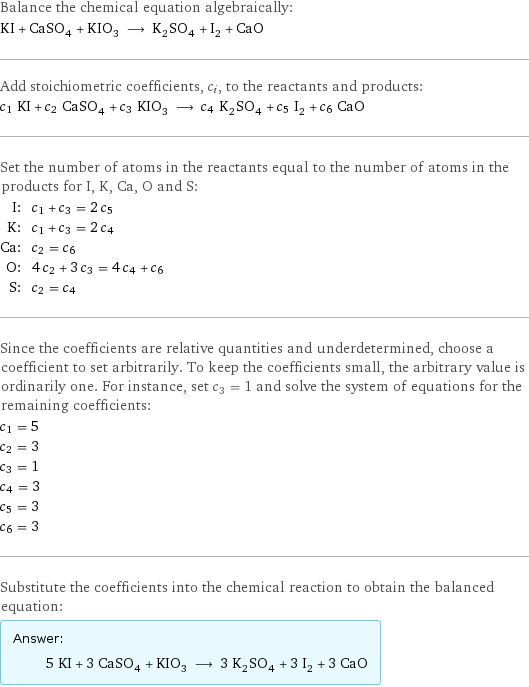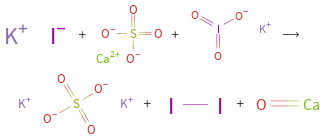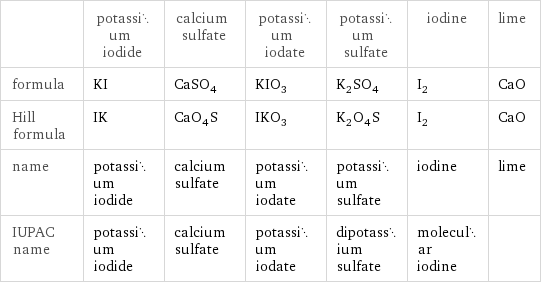Input interpretation

KI potassium iodide + CaSO_4 calcium sulfate + KIO_3 potassium iodate ⟶ K_2SO_4 potassium sulfate + I_2 iodine + CaO lime
Balanced equation

Balance the chemical equation algebraically: KI + CaSO_4 + KIO_3 ⟶ K_2SO_4 + I_2 + CaO Add stoichiometric coefficients, c_i, to the reactants and products: c_1 KI + c_2 CaSO_4 + c_3 KIO_3 ⟶ c_4 K_2SO_4 + c_5 I_2 + c_6 CaO Set the number of atoms in the reactants equal to the number of atoms in the products for I, K, Ca, O and S: I: | c_1 + c_3 = 2 c_5 K: | c_1 + c_3 = 2 c_4 Ca: | c_2 = c_6 O: | 4 c_2 + 3 c_3 = 4 c_4 + c_6 S: | c_2 = c_4 Since the coefficients are relative quantities and underdetermined, choose a coefficient to set arbitrarily. To keep the coefficients small, the arbitrary value is ordinarily one. For instance, set c_3 = 1 and solve the system of equations for the remaining coefficients: c_1 = 5 c_2 = 3 c_3 = 1 c_4 = 3 c_5 = 3 c_6 = 3 Substitute the coefficients into the chemical reaction to obtain the balanced equation: Answer: | | 5 KI + 3 CaSO_4 + KIO_3 ⟶ 3 K_2SO_4 + 3 I_2 + 3 CaO
Structures

+ + ⟶ + +
Names

potassium iodide + calcium sulfate + potassium iodate ⟶ potassium sulfate + iodine + lime
Equilibrium constant
![Construct the equilibrium constant, K, expression for: KI + CaSO_4 + KIO_3 ⟶ K_2SO_4 + I_2 + CaO Plan: • Balance the chemical equation. • Determine the stoichiometric numbers. • Assemble the activity expression for each chemical species. • Use the activity expressions to build the equilibrium constant expression. Write the balanced chemical equation: 5 KI + 3 CaSO_4 + KIO_3 ⟶ 3 K_2SO_4 + 3 I_2 + 3 CaO Assign stoichiometric numbers, ν_i, using the stoichiometric coefficients, c_i, from the balanced chemical equation in the following manner: ν_i = -c_i for reactants and ν_i = c_i for products: chemical species | c_i | ν_i KI | 5 | -5 CaSO_4 | 3 | -3 KIO_3 | 1 | -1 K_2SO_4 | 3 | 3 I_2 | 3 | 3 CaO | 3 | 3 Assemble the activity expressions accounting for the state of matter and ν_i: chemical species | c_i | ν_i | activity expression KI | 5 | -5 | ([KI])^(-5) CaSO_4 | 3 | -3 | ([CaSO4])^(-3) KIO_3 | 1 | -1 | ([KIO3])^(-1) K_2SO_4 | 3 | 3 | ([K2SO4])^3 I_2 | 3 | 3 | ([I2])^3 CaO | 3 | 3 | ([CaO])^3 The equilibrium constant symbol in the concentration basis is: K_c Mulitply the activity expressions to arrive at the K_c expression: Answer: | | K_c = ([KI])^(-5) ([CaSO4])^(-3) ([KIO3])^(-1) ([K2SO4])^3 ([I2])^3 ([CaO])^3 = (([K2SO4])^3 ([I2])^3 ([CaO])^3)/(([KI])^5 ([CaSO4])^3 [KIO3])](../image_source/212a7f94749b452c1552f11332f95b5f.png)
Construct the equilibrium constant, K, expression for: KI + CaSO_4 + KIO_3 ⟶ K_2SO_4 + I_2 + CaO Plan: • Balance the chemical equation. • Determine the stoichiometric numbers. • Assemble the activity expression for each chemical species. • Use the activity expressions to build the equilibrium constant expression. Write the balanced chemical equation: 5 KI + 3 CaSO_4 + KIO_3 ⟶ 3 K_2SO_4 + 3 I_2 + 3 CaO Assign stoichiometric numbers, ν_i, using the stoichiometric coefficients, c_i, from the balanced chemical equation in the following manner: ν_i = -c_i for reactants and ν_i = c_i for products: chemical species | c_i | ν_i KI | 5 | -5 CaSO_4 | 3 | -3 KIO_3 | 1 | -1 K_2SO_4 | 3 | 3 I_2 | 3 | 3 CaO | 3 | 3 Assemble the activity expressions accounting for the state of matter and ν_i: chemical species | c_i | ν_i | activity expression KI | 5 | -5 | ([KI])^(-5) CaSO_4 | 3 | -3 | ([CaSO4])^(-3) KIO_3 | 1 | -1 | ([KIO3])^(-1) K_2SO_4 | 3 | 3 | ([K2SO4])^3 I_2 | 3 | 3 | ([I2])^3 CaO | 3 | 3 | ([CaO])^3 The equilibrium constant symbol in the concentration basis is: K_c Mulitply the activity expressions to arrive at the K_c expression: Answer: | | K_c = ([KI])^(-5) ([CaSO4])^(-3) ([KIO3])^(-1) ([K2SO4])^3 ([I2])^3 ([CaO])^3 = (([K2SO4])^3 ([I2])^3 ([CaO])^3)/(([KI])^5 ([CaSO4])^3 [KIO3])
Rate of reaction
![Construct the rate of reaction expression for: KI + CaSO_4 + KIO_3 ⟶ K_2SO_4 + I_2 + CaO Plan: • Balance the chemical equation. • Determine the stoichiometric numbers. • Assemble the rate term for each chemical species. • Write the rate of reaction expression. Write the balanced chemical equation: 5 KI + 3 CaSO_4 + KIO_3 ⟶ 3 K_2SO_4 + 3 I_2 + 3 CaO Assign stoichiometric numbers, ν_i, using the stoichiometric coefficients, c_i, from the balanced chemical equation in the following manner: ν_i = -c_i for reactants and ν_i = c_i for products: chemical species | c_i | ν_i KI | 5 | -5 CaSO_4 | 3 | -3 KIO_3 | 1 | -1 K_2SO_4 | 3 | 3 I_2 | 3 | 3 CaO | 3 | 3 The rate term for each chemical species, B_i, is 1/ν_i(Δ[B_i])/(Δt) where [B_i] is the amount concentration and t is time: chemical species | c_i | ν_i | rate term KI | 5 | -5 | -1/5 (Δ[KI])/(Δt) CaSO_4 | 3 | -3 | -1/3 (Δ[CaSO4])/(Δt) KIO_3 | 1 | -1 | -(Δ[KIO3])/(Δt) K_2SO_4 | 3 | 3 | 1/3 (Δ[K2SO4])/(Δt) I_2 | 3 | 3 | 1/3 (Δ[I2])/(Δt) CaO | 3 | 3 | 1/3 (Δ[CaO])/(Δt) (for infinitesimal rate of change, replace Δ with d) Set the rate terms equal to each other to arrive at the rate expression: Answer: | | rate = -1/5 (Δ[KI])/(Δt) = -1/3 (Δ[CaSO4])/(Δt) = -(Δ[KIO3])/(Δt) = 1/3 (Δ[K2SO4])/(Δt) = 1/3 (Δ[I2])/(Δt) = 1/3 (Δ[CaO])/(Δt) (assuming constant volume and no accumulation of intermediates or side products)](../image_source/2c9a918bd9172b924be9b824b0758aa6.png)
Construct the rate of reaction expression for: KI + CaSO_4 + KIO_3 ⟶ K_2SO_4 + I_2 + CaO Plan: • Balance the chemical equation. • Determine the stoichiometric numbers. • Assemble the rate term for each chemical species. • Write the rate of reaction expression. Write the balanced chemical equation: 5 KI + 3 CaSO_4 + KIO_3 ⟶ 3 K_2SO_4 + 3 I_2 + 3 CaO Assign stoichiometric numbers, ν_i, using the stoichiometric coefficients, c_i, from the balanced chemical equation in the following manner: ν_i = -c_i for reactants and ν_i = c_i for products: chemical species | c_i | ν_i KI | 5 | -5 CaSO_4 | 3 | -3 KIO_3 | 1 | -1 K_2SO_4 | 3 | 3 I_2 | 3 | 3 CaO | 3 | 3 The rate term for each chemical species, B_i, is 1/ν_i(Δ[B_i])/(Δt) where [B_i] is the amount concentration and t is time: chemical species | c_i | ν_i | rate term KI | 5 | -5 | -1/5 (Δ[KI])/(Δt) CaSO_4 | 3 | -3 | -1/3 (Δ[CaSO4])/(Δt) KIO_3 | 1 | -1 | -(Δ[KIO3])/(Δt) K_2SO_4 | 3 | 3 | 1/3 (Δ[K2SO4])/(Δt) I_2 | 3 | 3 | 1/3 (Δ[I2])/(Δt) CaO | 3 | 3 | 1/3 (Δ[CaO])/(Δt) (for infinitesimal rate of change, replace Δ with d) Set the rate terms equal to each other to arrive at the rate expression: Answer: | | rate = -1/5 (Δ[KI])/(Δt) = -1/3 (Δ[CaSO4])/(Δt) = -(Δ[KIO3])/(Δt) = 1/3 (Δ[K2SO4])/(Δt) = 1/3 (Δ[I2])/(Δt) = 1/3 (Δ[CaO])/(Δt) (assuming constant volume and no accumulation of intermediates or side products)
Chemical names and formulas

| potassium iodide | calcium sulfate | potassium iodate | potassium sulfate | iodine | lime formula | KI | CaSO_4 | KIO_3 | K_2SO_4 | I_2 | CaO Hill formula | IK | CaO_4S | IKO_3 | K_2O_4S | I_2 | CaO name | potassium iodide | calcium sulfate | potassium iodate | potassium sulfate | iodine | lime IUPAC name | potassium iodide | calcium sulfate | potassium iodate | dipotassium sulfate | molecular iodine |
Substance properties

| potassium iodide | calcium sulfate | potassium iodate | potassium sulfate | iodine | lime molar mass | 166.0028 g/mol | 136.13 g/mol | 214 g/mol | 174.25 g/mol | 253.80894 g/mol | 56.077 g/mol phase | solid (at STP) | | solid (at STP) | | solid (at STP) | solid (at STP) melting point | 681 °C | | 560 °C | | 113 °C | 2580 °C boiling point | 1330 °C | | | | 184 °C | 2850 °C density | 3.123 g/cm^3 | | 1.005 g/cm^3 | | 4.94 g/cm^3 | 3.3 g/cm^3 solubility in water | | slightly soluble | | soluble | | reacts dynamic viscosity | 0.0010227 Pa s (at 732.9 °C) | | | | 0.00227 Pa s (at 116 °C) | odor | | odorless | | | |
Units
